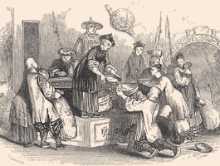This is a List of famines in China, part of the series of lists of disasters in China. Between 108 BC and 1911 AD, there were no fewer than 1,828 recorded famines in China, or once nearly every year in one province or another. The famines varied in severity.[1][2]


Famines in China
| Name | Time | Region | Context | Estimated number of dead |
|---|---|---|---|---|
| 875–884 | Peasant rebellion in China inspired by famine; Huang Chao captured capital | |||
| Chinese famine of 1333-1337 | 1333–1337[3] | Famine in China | 6 million[4] | |
| 1630–1631 | Northwestern China | Eventually causing the Ming dynasty to collapse in 1644 | ||
| 1810, 1811, 1846, 1849 | Unknown (45 million population decrease, unknown how many emigrated or avoided census to evade taxes)[5] | |||
| 1850–1873 | Nian Rebellion, Taiping Rebellion and drought | Primarily caused by famine, lower life expectancy and plague in the case of the Nian rebellion, the total war casualties are claimed to possibly be 10–30 million people[6][7] | ||
| Northern Chinese Famine of 1876–79 | 1876–1879 | Mostly Shanxi (5.5 million dead), also in Zhili (2.5 million), Henan (1 million) and Shandong (0.5 million).[8] | Drought | 9.5–13 million[9] |
| Northern Chinese Famine of 1901 | 1901 | Shanxi, Shaanxi, Inner Mongolia | The drought from 1898-1901 led to a fear of famine, which was a leading cause of Boxer Rebellion. The famine eventually came in Spring 1901.[10] | 0.2 million in Shanxi, the worst hit province. |
| Chinese famine of 1906–1907 | 1906-07 | northern Anhui, northern Jiangsu | 20-25 million [11] | |
| Chinese famine of 1920-1921 | 1920–1921 | Henan, Shandong, Shanxi, Shaanxi, southern Zhili (Hebei) | 0.5 million[12] | |
| Chinese famine of 1928–30 | 1928–1930 | Northern China | Drought, wartime constraints, and inefficiency of relief[13] | 6-10 million [14] |
| 1942–1943 famine | 1942–1943 | Mainly Henan | Second Sino-Japanese War | 0.7-1 million[15] |
| Great Chinese Famine | 1959–61[16] | Half of the country, in particular Anhui (18% died), Chongqing (15% died), Sichuan (13% died), Guizhou (11% died), Hunan (8% died)[17] | Great Leap Forward, Floods, Droughts, Typhoons, Insect Invasion[18] | 2.6 million to 55 million[19][17][20] |
Responding to famines

In China famines have been an ongoing problem for thousands of years. From the Shang dynasty (16th-11th century BC) until the founding of modern China, chroniclers have regularly described recurring disasters. There have always been times and places where rains have failed, especially in the northwest of China, and this has led to famine.
It was the task of the Emperor of China to provide, as necessary, to famine areas and transport foods from other areas and to distribute them. The reputation of an emperor depended on how he succeeded. National famines occurred even when the drought areas were too large, especially when simultaneously larger areas of flooded rivers were over their banks and thus additionally crop failures occurred, or when the central government did not have sufficient reserves. If an emperor could not prevent a famine, he lost prestige and legitimacy. It was said that he had lost the Mandate of Heaven.
Qing China built an elaborate system designed to minimize famine deaths. The system was destroyed in the Taiping Rebellion of the 1850s.[21][22]
See also
References
Further reading
- Bohr, Paul Richard. Famine in China and the missionary: Timothy Richard as relief administrator and advocate of national reform, 1876–1884 (Brill, 2020).
- Edgerton-Tarpley, Kathryn Jean. "From 'Nourish the People' to 'Sacrifice for the Nation': Changing Responses to Disaster in Late Imperial and Modern China." Journal of Asian Studies (2014): 447-469. online
- Edgerton-Tarpley, Kathryn, and Cormac O'gr. Tears from iron: cultural responses to famine in nineteenth-century China (U of California Press, 2008).
- Li, Lillian M. Fighting famine in North China: state, market, and environmental decline, 1690s-1990s (Stanford UP, 2007).
- Maohong, Bao. "Environmental history in China." Environment and History (2004): 475-499. online
- Shiue, Carol H. "The political economy of famine relief in China, 1740–1820." Journal of Interdisciplinary History 36.1 (2005): 33-55. online
- Shiue, Carol H. "Local granaries and central government disaster relief: moral hazard and intergovernmental finance in eighteenth-and nineteenth-century China." Journal of Economic History (2004): 100-124. online
- Will, Pierre-Etienne, and R. Bin Wong. Nourish the people: The state civilian granary system in China, 1650–1850 (University of Michigan Press, 2020).